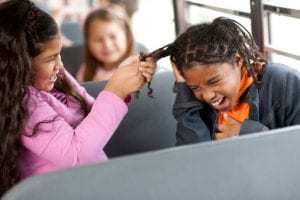What is it?

According to StopBullying.org, “Bullying is unwanted, aggressive behavior among school aged children that involves a real or perceived power imbalance. The behavior is repeated, or has the potential to be repeated, over time.”
The CDC states that although not all bullying is physical, any type of bullying can cause damage to a person
- Physical such as hitting, kicking, and tripping
- Verbal including name-calling and teasing
- Relational/social such as spreading rumors and leaving out of the group
- Damage to property of the victim
- Cyberbullying occurs through technology and often includes making fun, name calling and recruiting others to join in
What to say to your child
It can be difficult to know what to say to your child if he/she is being bullied. According to KidsHealth these strategies are effective ways to deal with bullies:
Ignore the bully. If you can, try your best to ignore the bully’s threats. Pretend you don’t hear them and walk away quickly to a place of safety. Bullies want a big reaction to their teasing and meanness. Acting as if you don’t notice and don’t care is like giving no reaction at all, and this just might stop a bully’s behavior.
Stand up for yourself. Pretend to feel really brave and confident. Tell the bully “No! Stop it!” in a loud voice. Then walk away, or run if you have to. Kids also can stand up for each other by telling a bully to stop teasing or scaring someone else, and then walking away together. If a bully wants you to do something that you don’t want to do, say “no!” and walk away. If you do what a bully says to do, the mean kid is more likely to keep bullying you. Bullies tend to pick on kids who don’t stick up for themselves.
Don’t bully back. Don’t hit, kick, or push back to deal with someone bullying you or your friends. Fighting back just satisfies a bully and it’s dangerous, too, because someone could get hurt. You’re also likely to get in trouble. It’s best to stay with others, stay safe, and get help from an adult.
Don’t show your feelings. Plan ahead. How can you stop yourself from getting angry or showing you’re upset? Try distracting yourself (counting backwards from 100, spelling the word ‘turtle’ backwards, etc.) to keep your mind occupied until you are out of the situation and somewhere safe where you can show your feelings.

Why do they do it?
The most common reason for bullying is seeking attention. Bullies believe that by making someone else feel small, they look big or important. They feel powerful when they have control.
It is also important to realize that some kids who bully have been exposed to bullying and are simply modeling that behavior. They may live in a home where there is violence and have been bullied themselves. These children may need help to realize that their behavior is hurtful and inappropriate.

Where to go to learn more
If your child is being bullied at school, you should contact your school’s representative (teacher, principal, counselor, superintendent etc.). You can also find help at these websites:
https://www.schoolsafety.gov/bullying-and-cyberbullying
/https://www.childhelp.org/
https://www.stopbullying.gov/resources/laws/ohio
Resources
CDC Fast Fact: Preventing Bullying, September 2021, https://www.cdc.gov/violenceprevention/youthviolence/bullyingresearch/fastfact.html
Dealing with Bullies, https://kidshealth.org/en/kids/bullies.html?ref=search
What is Bullying?, April 2021, https://www.stopbullying.gov/
https://www.schoolsafety.gov/bullying-and-cyberbullying